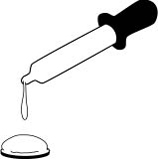|
Drops
on a Penny: Student Worksheet

Name: ____________________________________

Water has a tendency to
act as if it has a very thin net stretched over its surface. This
tendency is called surface tension. Surface tension is caused by the
polar nature of the water molecule.
The polar charges are caused by electron sharing of the atoms of the
molecule. This sharing causes areas of the molecules to become positively
and negatively charged. The charged areas are called poles. Opposite
charges attract causing the pole on one molecule to be attracted and
"cling" to an oppositely charged pole of another molecule.
This cling, or adhesion, of molecules forms the "net" called
surface tension. As water piles up on a penny, it creates a dome-like
shape. It will even bulge over the edge of the penny. The "net"
of surface tension keeps the water from spilling off. Surface tension
will support this bulging dome until the water piles up so high that
the force of gravity on the water becomes greater than the strength
of the net and it is ripped open as the polar bonds are broken.

Students work in pairs

- Dixie cups
- Water
- Eye Dropper
- Paper towels
- Pennies

- COLLECT THE DATA
- Guess how many drops of water a Heads-Up penny will hold.
- Count how many drops it will actually hold.
- Record your data.
- GRAPH THE DATA
Create a Stem-and-Leaf plot of the class data.
- ANALYZE THE DATA
- Use the data to calculate the mean, median, mode and range.
- Use this data to create a box and whiskers plot.

As a result of this activity,
students will learn to model and graph stem-and-leaf plots and box
and whiskers plots.

- Predict how many drops
of water a Tails-Up penny will hold and check your prediction.
- Draw a box and whiskers
plot and compare to the plot for the Heads-Up penny.
|